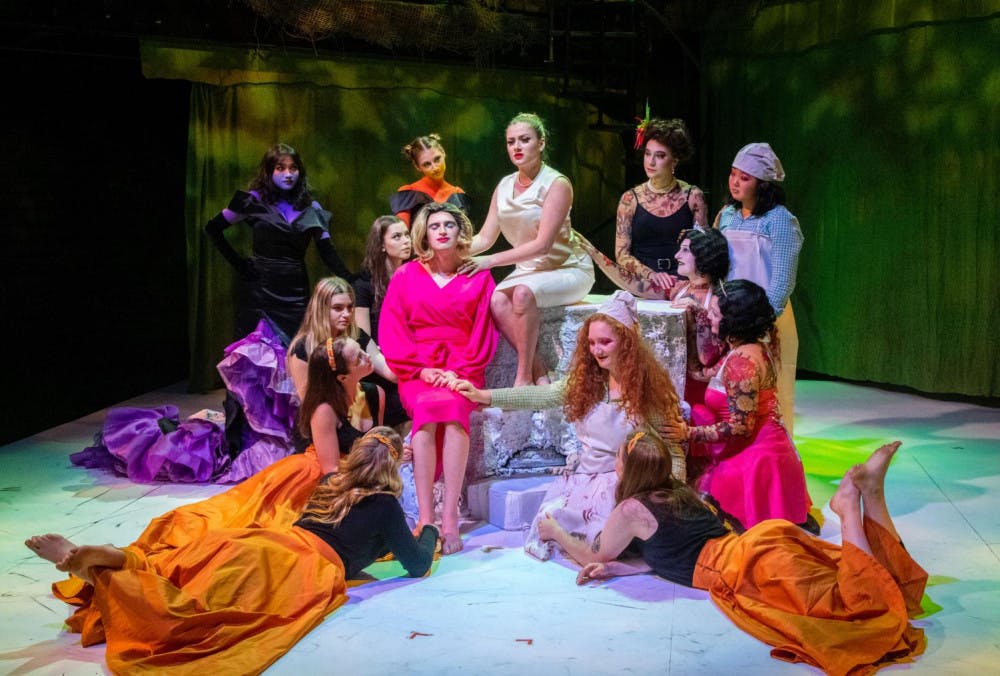Throat singing, multilingual monologues, aerial dance, hyperfemininity, hypermasculinity, Max Ernst aesthetics, blood, violence, sexual references and many more contrasting and disparate elements came together last weekend at the Mahaney Arts Center. The 90 minutes of Director and Assistant Professor of Theatre Michole Biancosino’s interpretation of “The Bacchae 2.1” ran from Oct. 31 to Nov. 2 at Seeler Studio Theatre. The production starred Kevin Collins ’20 (as Pentheus) and Marci Urban ’22.5 , Cecelia Scheuer ’21 and Zachary Varricchione ’21 (all three as Dionysus), with music by visiting artist Neel Murgai and Ronnie Romano ’20. Murgai looked to Hindu Shiva for inspiration while adopting different ragas and improvising throughout the show.
“Bacchae” was written by Euripides in the fifth century B.C. as a perplexing and disturbing study of the clash and struggle between wilderness and civilization. This Greek tragedy, along with other pre-existing texts, were appropriated and adapted into a new creation by Charles Mee in 1993. Mee’s version incorporated much more violence and sexual reference while also adding layers to the discussion of the complexity of human nature. Gender relations, suppression, identity, dialectics and plurality all became subjects of interest to Mee.
Yet Biancosino made the play into, as she says, “a Bacchae 2.1a or 3.1.” When she began working with the company on this rather messy play with “jarring juxtapositions,” as she phrased it, Biancosino took it as a creative challenge to sort out how far they can go with some of the ideas dealt with in the play. She and the actors worked hard to fill the play with humanity while preserving its poetic nature. After all the creative and artistic additions to the play, the core of the show still lies in its discussion of otherness, which gives it relevance in any historical context.
The significance of putting on a show that discusses modernity, civilization and otherness is not trivial at the college. Biancosino believed that “The Bacchae 2.1” is inherently an acknowledgement to the people who don’t fit in and to the otherness that barely has space at a “white institution that’s known as a ‘pillar of civilization.’”
The tone of Biancosino’s “The Bacchae” was exactly that: She was careful, conscientious and creative with how to present otherness at the college in 2019. She started with tossing out the inflammatory parts in Mee’s version and bringing in other voices, including works of queer writers and writers of color. These elements created a poetic and more comprehensive understanding of the world. Further, Biancosino purposefully made the connotation of the color orange ambiguous: A tainted and deceptive orange downplays its symbolism as the “Eastern color” used in Mee’s interpretation.

“The Bacchae 2.1” is a reinterpretation of Charles Mee’s 1993 interpretation of the 405B.C. Greek tragedy, “Bacchae.”
The representation of otherness is detail-oriented, evident through how makeup was a means to showcase and discern various groups of characters. Stern blue suits with minimal makeup made Pentheus look “strict and conservative,” while the women in the mountains have “whimsical and outgoing” looks to help establish their characters, said makeup artist Devon Hunt ’23.
Further, Biancosino pondered how to bring otherness on stage in novel ways. Her most daring redesign was to use a multilingual approach including German, Spanish, Mandarin, Bengali, ASL and others. Indeed, what’s a more Middlebury thing to do than showcasing students’ linguistic talents? This was at times disorienting. As the Lavender Woman (Nuasheen Chowdhury ’22) began speaking Bengali, evident gasps among audiences reveal how some felt utterly lost. But the value of this approach lies in its ability to force audiences to move pass literal meanings, and propel the audience to look at otherness in a uniquely Middlebury way.
The actors were able to bring this complicated show together in a short seven weeks, and they each contributed their unique understanding of its message to the performance. Director Biancosino allowed a great deal of freedom for actors when exploring their characters.
“As an actor, I had to let go of my dependence on rationality and logic in order to fully engage with and find meaning in this play’s poetic and visceral language,” Gabby Valdivieso ’20 (tattoo artist) said. In order to develop her character, she “explored the history of how women with tattoos have been perceived — from tattooed women put on display as sideshow attractions to tattoos not aligning with conventional ideas of femininity to feminist beliefs in empowerment and body ownership.” In a similar way, Madeline Ciocci ’20 (Agave) said her character “has a complete shift at the end of the play, where she gets primal and animalistic, and afterwards, she seems like a totally different person. She is much more real and raw at the end." In order to best present such a drastic shift, she is conscious of her postures, language and how she interacts with other characters.
The actors’ diligent inputs led to commends among audiences. The intensity of the play left many in awe as they leave the studio. There was so much to grab the audience’s attention and people were invariably drawn to different things: as some focused on the image of blossoming rose on the backdrop, some looked at the chatty Bacchae aside and others stared at the musician.
Bair Lambert ’22, who played a supporting role in the play, said days before the play that he hoped audiences would walk out thinking “What the f**k!” I certainly felt that way, and many around me concurred. “The Bacchae 2.1” was not a narrative, nor a story, but an experience, an utterly intense one that impels deep reflections about otherness.

Rain Ji '23 is a managing editor of The Campus. She previously served as an Arts & Culture editor.
She is majoring in International and Global Studies with a concentration in the Middle East and North Africa. Previously, she studied abroad in Amman at the University of Jordan. Outside of academics, she enjoys watching Criminal Minds and skiing.




